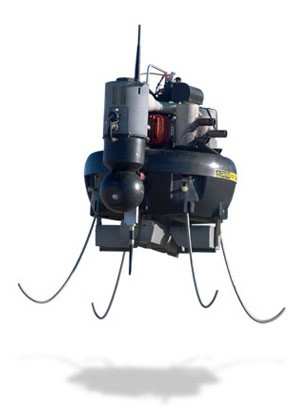Fri, Apr 22, 2011
Honeywell T-Hawk Provides Video Feed To Remote Monitors
Crews working to contain radiation and diagnose problems at
Japan’s Fukushima Daiichi nuclear facility get up-close video
and photos inside the plant as they work from a source rarely seen
outside military circles. Three employees of Honeywell have flown
five successful missions with the company's T-Hawk Micro Air
Vehicle (MAV), capturing hours of video and dozens of photos of the
nuclear reactor. The four T-Hawks in service at Fukushima Daiichi
have been adapted to carry radiation sensors.

“On behalf of all of us at Honeywell, our hearts go out to
the people of Japan, particularly those who have suffered as a
result of the earthquake and tsunami that damaged the Fukushima
Daiichi nuclear plant and surrounding areas,” said Tim
Mahoney, president and chief executive officer of Honeywell
Aerospace. “At Honeywell, we are proud of our commitment to
safety and security, and we are grateful that our technologies can
be deployed now to help the people of Japan in this historic time
of need.”
Currently deployed in war zones in Iraq and Afghanistan, the
T-Hawk features unique hover-and-stare capability that enables
pilots to hold it in one place and zoom in on features inside the
damaged reactors while the T-Hawk sends live video and still images
back to recovery workers. The T-Hawk also is capable of sending
live in-flight video feeds to help workers focus on critical areas
and adjust direction mid-flight. Pilots can control T-Hawk cameras
to alter angles and get better views of damaged equipment. Just 14
inches in diameter, the T-Hawk can be flown into tight spaces where
humans and other aircraft cannot go.
“The T-Hawk reminds us that innovative technologies
initially created for defense purposes can find crucial roles in
humanitarian and disaster recovery efforts,” Mahoney
said.

Weighing just 17 pounds, the T-Hawk is a ducted-fan vertical
takeoff and landing air vehicle originally designed in conjunction
with a Defense Advanced Research Projects Agency (DARPA) Advanced
Concept Technology Demonstration (ACTD) program. Pilots can
determine manual or autonomous flight paths from up to six miles
away for up to 40 minutes at a time.
The T-Hawk is a proven force multiplier in Afghanistan and Iraq,
where systems have been averaging more than six hours of flight
time a day. The T-Hawk is used in Afghanistan for route clearance,
infantry assault, and explosive ordnance disposal missions, where,
together with its similar work in Iraq, it has cumulatively flown
more than 17,000 hours. The United Kingdom’s Ministry of
Defence also deploys the T-Hawk for combat missions in Afghanistan
and trains with the T-Hawk in Afghanistan and Jordan. The T-Hawk is
currently being tested for urban use by the Miami-Dade Police
Department.
More News
From 2014 (YouTube Version): One Of The Airshow World's Pre-Eminent Formation Teams Chats About The State Of The Industry At EAA AirVenture 2014, ANN News Editor Tom Patton gets th>[...]
Tactical Air Navigation (TACAN) An ultra-high frequency electronic rho-theta air navigation aid which provides suitably equipped aircraft a continuous indication of bearing and dis>[...]
Aero Linx: Doobert Hi, we're Chris & Rachael Roy, founders and owners of Doobert. Chris is a technology guy in his “day” job and used his experience to create Doobe>[...]
The Airplane Was Spinning In A Nose-Down Attitude Before It Impacted Terrain On June 20, 2025, at 0900 eastern daylight time, a Pitts Aerobatics S-2B, N79AV, was destroyed when it >[...]
Also: United Elite Sues, Newark ATC Transitions, Discovery Moves?, Textron @ KOSH The Commemorative Air Force Airbase Arizona is taking its “Flying Legends of Victory Tour&rd>[...]
 Classic Aero-TV: Up Close And Personal - The Aeroshell Aerobatic Team at Oshkosh
Classic Aero-TV: Up Close And Personal - The Aeroshell Aerobatic Team at Oshkosh ANN's Daily Aero-Term (07.13.25): Tactical Air Navigation (TACAN)
ANN's Daily Aero-Term (07.13.25): Tactical Air Navigation (TACAN) ANN's Daily Aero-Linx (07.13.25)
ANN's Daily Aero-Linx (07.13.25) NTSB Prelim: Pitts S2
NTSB Prelim: Pitts S2 Airborne 07.09.25: B-17 Sentimental Journey, Airport Scandal, NORAD Intercepts
Airborne 07.09.25: B-17 Sentimental Journey, Airport Scandal, NORAD Intercepts



